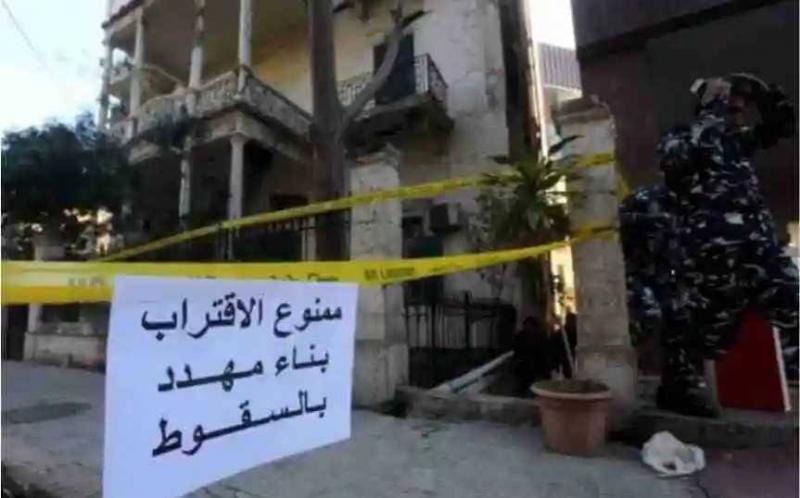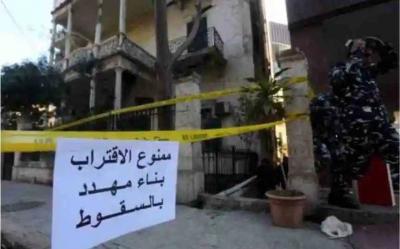Buildings are considered one of the most important assets individuals own, as they are not just places for residence but represent significant investments that may last for decades. The instability and cracking of houses are common problems faced by property owners, causing engineering disruptions and aesthetic deformities that may affect property value and residents' safety, according to "Ad-Diyar." In this context, hundreds of buildings are suffering from structural imbalances and threats of collapse, especially after the explosion on August 4, 2020, which caused immense damage to buildings and increased pressure on infrastructure and older buildings in the surrounding areas. The Lebanese government conducted a comprehensive assessment of housing in Beirut and neighboring areas in 2021 to identify buildings that suffer from hazardous cracks that could lead to their collapse and require urgent repairs or safety measures to reduce collapse risks. This situation presents a significant challenge for the government, especially amid the current economic crisis.
In this context, several architects interviewed by "Ad-Diyar" stressed the need for various preventive measures, including:
- **Infrastructure Assessment**: Relevant authorities must regularly assess infrastructure and old buildings to identify those that need urgent repairs and maintenance, while the government should improve public infrastructure to prevent neglect that could lead to human disasters.
- **Regular Maintenance**: It is essential to carry out regular maintenance to ensure building safety and avoid the accumulation of structural problems.
- **Strict Monitoring**: The government should intensify monitoring of construction operations to ensure that they are completed according to engineering and construction standards.
- **Public Awareness**: There should be efforts to educate people about the importance of regular maintenance and to avoid old buildings that show significant cracking as it may be dangerous to stay in them.
**Most Affected Areas**
- The areas of Beirut and its suburbs are among the most affected by rainfall, which has damaged housing units and caused structural disruptions, jeopardizing the foundations and safety of buildings.
- The Burj Hammoud area is experiencing significant population density and consists of many old buildings that are at risk of being affected by rainwater and foundation deterioration due to regular and adequate maintenance not being carried out.
- In Tripoli and areas of northern Lebanon in general, there are many old housing units that may be historical or culturally valuable, but often suffer from deterioration due to a lack of regular maintenance and the effects of environmental factors.
- In the Bekaa, which is a rural and agricultural area, there are numerous ancient residences and palaces built centuries ago that require restoration.
- To the south, the southern regions are known for their natural beauty and rich history, hosting many historical and heritage sites, such as the coastal city of Tyre which includes many Roman and Phoenician ruins, along with historic homes that need to be uncovered.
- Additionally, areas near the border with occupied Palestine contain many buildings suffering from deterioration due to difficult security and social conditions in the region.
**Approximate Numbers Not Final**
In parallel, the head of the "Building Safety Network," Engineer Youssef Fouzi Azam, clarified to "Ad-Diyar" that discussions in the media mention the figure of 16,250 buildings at risk of collapsing, especially after the earthquakes in Turkey and Syria, which was published in 2013. However, he pointed out that this number is outside its scientific context, referring to the method through which it was obtained. He added that in 2013 a building collapsed in the Fasouh area, and this disaster was the catalyst at that time that raised awareness among the public and officials about the seriousness of this issue, realizing that a catastrophe could affect a large number of buildings.
**A Quick Plan**
He continued: At that time, there was cooperation between the Ministry of Interior and Municipalities during the tenure of former Minister Marwan Charbel, who appointed one of his advisors to follow up this issue. He also sent a notice asking municipalities to cooperate with the Building Safety Network regarding risk prevention in buildings and how to carry out field surveys. In addition, we visited most municipalities and collected aerial maps and managed to obtain other documents from our private sources. He noted that these efforts were prepared voluntarily by the association's engineers and incorporated into a GIS mapping program for analysis based on a chronological arrangement, which showed us the number of buildings according to the ages that were the benchmark.
He stated: "I insist that this measure does not represent the correct model, as the correct approach involves conducting an on-ground survey by first conducting a theoretical examination and then moving on to laboratory tests. Samples of iron and concrete must also be taken to determine the building's lifespan; this is the best method, and municipalities should adopt it rather than private associations."
He added: "It was necessary, in light of the absence of numbers, to demonstrate the size of the problem, so we obtained the geographical distribution and numbers related to these units based on the maps we collected. After approximately a year of work in this area, we found there are about 400 homes in Burj Hammoud. Of course, we arrived at this figure through the aforementioned method, but the numbers could be more or less.
He addressed the municipalities that are responsible for conducting inspections, as the goal of the municipality is to facilitate public services and ensure people's safety. The methodology we followed was based on age, which enabled us to conduct an enumeration of buildings threatened with collapse. I reaffirm that this mechanism is not the optimal engineering method for accurately knowing the numbers; the best approach is for the municipality to conduct a survey, which is part of its responsibilities."
Azam said: "The older a building is, the more difficult its structural situation becomes. These buildings are considered threatened due to the wars that have struck Lebanon, along with the regularization of violations and the informal areas."




